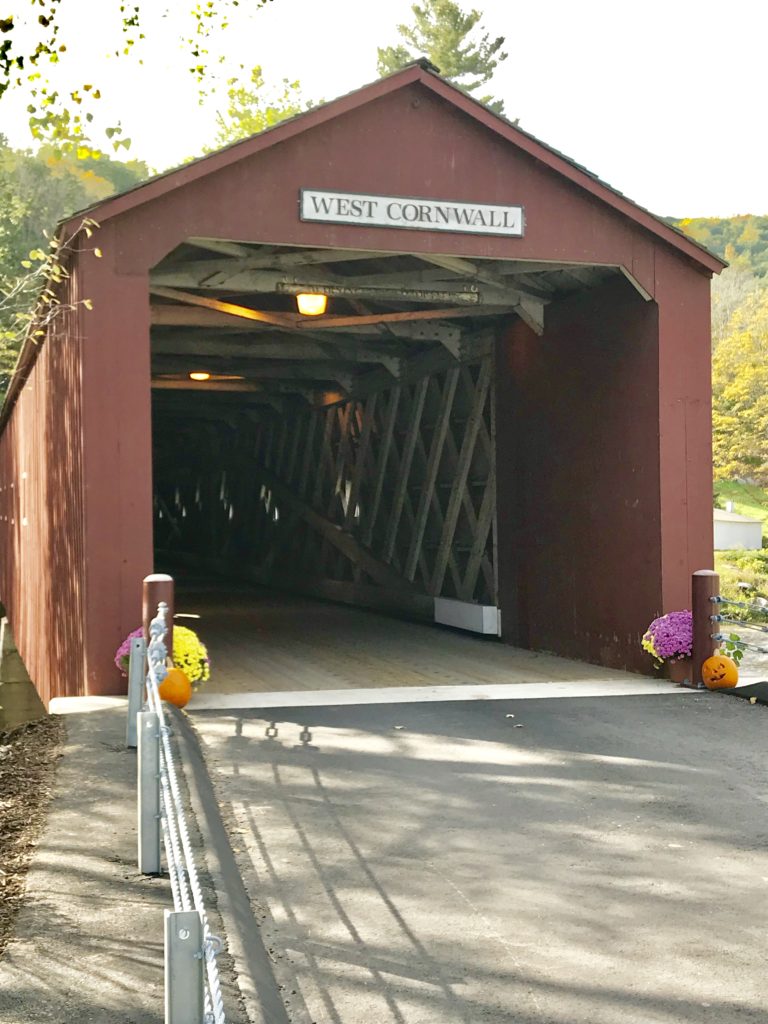Back to Introduction & Lessons at a Glance

Introduction
Covered bridges dot the landscape across New England but there are only three remaining in Connecticut. They were an important architectural and commercial element in the growth of America. In this lesson students examine the architecture of the covered bridge in Cornwall, Connecticut, and then build their own bridges to contrast the pros and cons of different designs.
Lesson Objective
By building and contrasting tress and suspension bridges, students will determine how bridges support weight in different ways.
Grade Level
3 - 6
Introductory Discussion Questions
Begin with an in-class conversation about how early Connecticut settlers crossed rivers and streams so that the mail, farm produce, and manufactured goods could be transported across the state. At first, wood was the favored building material for bridges because it was plentiful and easy to work with. Advances in engineering and technology enabled bridges to be built across wider and wider rivers. Here are some questions to help guide the discussion.
Q. How did early travelers cross large streams or rivers before there were bridges?
A. Either by crossing on horseback or wading at a shallow spot, crossing on a boat like a ferry.
Q. What is a bridge?
A. A bridge is a structure carrying a road, path, railroad, or canal over a river, ravine, road, railroad, or other obstacle.
Q. How does a bridge work?
A. The simplest bridge is a plank that reaches from bank to bank. But that type of bridge can’t carry heavy loads or reach across long distances. Engineers since ancient times have had to find ways to build strong bridge structures that can reach across a river, and withstand the pull of gravity, withstand the elements such as rain, sun, wind, and snow, and carry traffic. Many designs have been developed: beam, arch, suspension, truss, and cantilever.
Q. What type of bridge is the West Cornwall Covered Bridge?
A. The West Cornwall Covered Bridge is a covered lattice truss bridge carrying the Sharon-Goshen Turnpike over the Housatonic River in the town of Cornwall. Built in about 1864, the wooden bridge is significant for two reasons. It is one of only three covered bridges remaining in Connecticut and it was designed by an important Connecticut architect and engineer: Ithiel Town.
Q. What does a civil engineer do?
A. A civil engineer designs and maintains roads, bridges, dams, and similar structures.
Q. What are modern bridges made of?
A. Steel and concrete
Q. What bridges do you know about? What bridges have you been over? Is there a bridge in your town?
Lesson Activity & Procedure
1. After discussing the previous questions, invite the students to investigate the covered bridge. In this case we will be examining the West Cornwall Bridge.
West Cornwall Bridge
2. As students investigate the West Cornwall covered bridge they should write down three pieces of information about how the bridge is constructed including its materials and features.
3. Students will form two groups to construct two types of bridges: a truss bridge, much like the West Cornwall Bridge, and a suspension bridge. Substantial planning and resources will be necessary to complete this worthwhile class activity using the link below:
Building a truss bridge vs suspension bridge
4. Once the bridges are built, students can answer the following analytical questions:
a. Which bridge do you think is stronger? Why?
b. Which could be built faster? Why?
c. Which could be built cheaper? Why?
d Which could allow for more traffic underneath? Why?
5. Exit slip: The most important difference between a truss and suspension bridge is ____________________________
Additional Resources
The West Cornwall Covered Bridge is listed on the National Register of Historic Places, National Park Service, U.S. Dept. of the Interior.
Nomination, National Register of Historic Places, Bruce Clouette, Ph.D, 1975.
https://en.wikipedia.org/wiki/West_Cornwall_Covered_Bridge
Connecticut Explored
Carry Me Across the Water Our Historic Bridges
Connecticuthistory.org
https://connecticuthistory.org/west-cornwall-covered-bridge-an-icon-of-new-england-craftsmanship/
https://connecticuthistory.org/town-patents-the-lattice-truss-bridge-today-in-history/
https://connecticuthistory.org/american-architect-ithiel-town-born-today-in-history/
https://connecticuthistory.org/the-comstock-bridge-brings-east-hampton-residents-together/
Word Wall
Lattice, civil engineer, covered bridge, architecture
State Standards
Alignment
HISTORY
Causation and Argumentation
· How have science, technology and innovation affected the development of towns and cities in Connecticut?
ECONOMICS
Economic Decision-Making
ECO 3.1 Compare the benefits and costs of individual choices.
Compelling Question:
· How do we trade for goods and services?
Supporting Questions:
· Why do we live where we live?
· How do we get the things we need to live (food, clothing, goods, etc.)?
Exchange and Markets
Supporting questions:
· How have science, technology, innovation, and natural resources affected the development of our community and state?
· In what ways have the rivers and waterways in Connecticut influenced economic development?
GEOGRAPHY
Human-Environment Interaction: Places, Regions, and Culture
GEO 3.4Explain how culture influences the way people modify and adapt to their environments.
GEO 3.5Explain how the cultural and environmental characteristics of places change over time.
GEO 3.6 Describe how environmental and cultural characteristics influence population distribution in specific places or regions.
Supporting Questions:
· How is the “identity” of a state or region created?
· What are some of Connecticut’s cultural and historical resources and how did they affect how people lived?
Human Population: Spatial Patterns and Movement
GEO 3.7, 3.8, 3.9 Supporting questions:
· Who controls the use of land and resources?
· How are rivers and resources in Connecticut used to develop communities and economic systems?
What attracts a person to a town or city today? How is that different from what may have attracted them there in 1800?